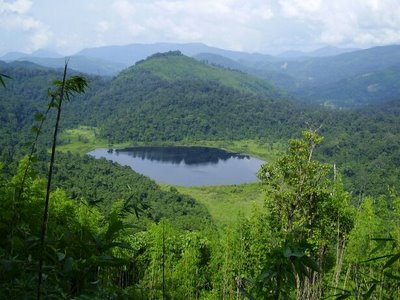The Mizoram state has three types of (natural) lakes: valley lakes, tectonic/landslide lakes and artificial reservoirs, but the only lake of significance is Palak Dil, which is a natural lake in a depression in the hills. Palak Dil may possibly be a combination of valley and tectonic lakes. Locally in Mizoram, lakes are called dils. There are many such dils scattered all over the state, but they are tiny pools or marshy depressions such as Rengdil, Tamdil and Mampui Dil (Choudhury 2002). The Palak Lake is situated within the Mara Autonomous district Council, which is a region inhabited by the Mara Tribe. The Maras are distinct from the majority Mizos and in the Mara language the Palak Lake is referred to as Pala Tipa.
The Palak Dil, the largest lake in Mizoram is situated about 100 Km from the district headquarter of Saiha and situated within the Tuipang sub division. The dimension of the lake is 400 m x 600 m, and depth is about 13 m (Datta-Roy et al. 2007). Two small mountain streams flow into the lake, and one streams flows out, ensuring a constant supply of fresh water. The forest around the lake is Tropical Wet Evergreen. Many of the nearby hills are covered by jhum (slash and burn cultivation), bamboo brakes as well as woody vegetation. An interesting feature of the forests surrounding the lake is the presence of low lying swamps which transform in to shallow lakes during the monsoon. The lake is surrounded by moderately steep hills. The area has Dipterocarp-dominated Tropical Evergreen Forest. The forests are rich in palms, rattans, dense cane-brakes and reeds along the lake margin (Birand and Pawar 2001).
The lake has many myths and legends attached to its origin and is also revered and feared by the locals as an abode of evil spirits. The taboos have, however, been diluted over the years and now-a-days people from the adjoining villages visit the lake to catch fish regularly (Datta Roy et al 2007).
 Avifauna
Avifauna
Over 70 species of birds were recorded from the region during a three day IBA survey (Birand and Pawar 2001), though the bird life is certainly much richer. A later survey by Datta-Roy et.al.(2007) recorded 136 species of avifauna from the lake and its surrounding forests spread across three seasons. Common moorhen can be regularly seen with occasional sightings of the threatened Darter. Other migratory birds, though have not been recorded. Most of the other species recorded are forest birds such as the Great Hornbill Buceros bicornis, Grey Peacock Pheasant Polyplectron bicalcaratum, Pale-chinned Flycatcher Cyornis poliogenys, Black-backed Forktail Enicurus immaculatus, and Lesser Necklaced Laughingthrush Garrulax monileger, Chestnut-winged Cuckoo Clamator jacobinus, White-rumped Shama Copsychus saularis, Red-headed Trogon Harpactes erythrocephalus, Long-tailed Broadbill Psarisomus dalhousiae, Silver-breasted Broadbill Serilophus lunatus, Greater Necklaced Laughingthrush Garrulax pectoralis, Bay Woodpecker Blythipicus pyrrhotis, Orange-bellied Chloropsis Chloropsis hardwickii, White-throated Bulbul Alophoixus flaveolus and Nepal Fulvetta Alcippe nipalensis. and Lesser Necklaced Laughingthrush Garrulax monileger.
/articles/palak-dil-lake-mizoram